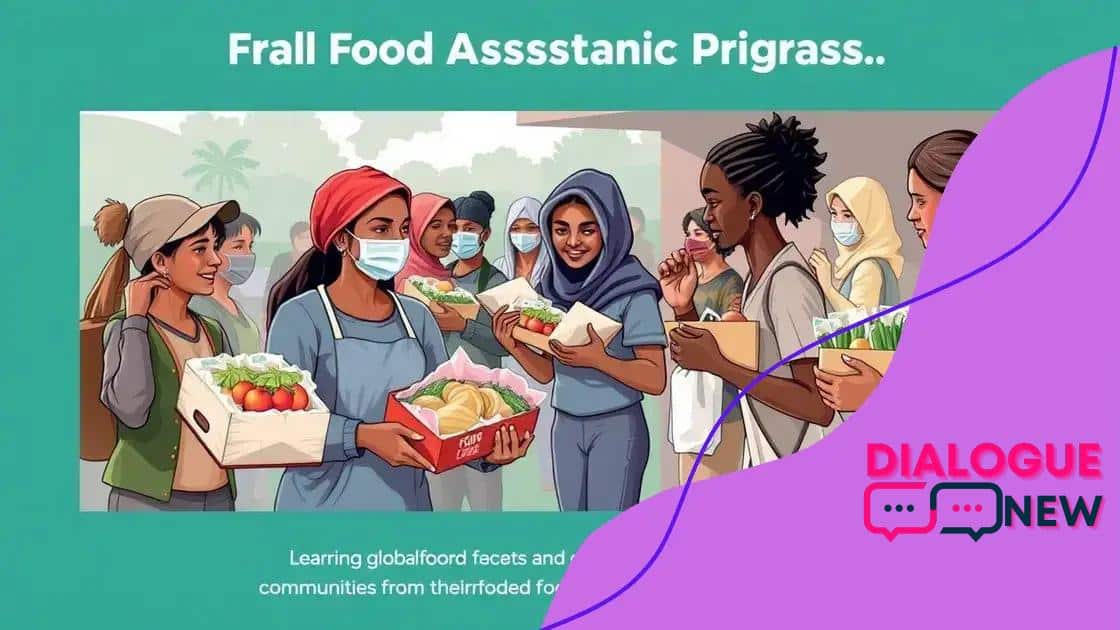Global food assistance program improvements: a new approach

The future of global food assistance programs focuses on integrating technology, promoting sustainability, and enhancing nutrition to effectively address food insecurity and empower communities.
Global food assistance program improvements are becoming increasingly vital as we face challenges in food security. Have you ever wondered what innovative strategies could enhance these programs? Let’s dive into this important topic.
Understanding the current global food assistance programs
Understanding the current global food assistance programs is crucial for addressing food insecurity worldwide. These programs are vital in providing aid to those in need, enhancing nutrition, and promoting food security. By examining how these initiatives work, we can uncover their strengths and areas for improvement.
Current Food Assistance Programs
Many countries implement food assistance programs that vary in scope and approach. These initiatives aim to distribute food, deliver financial assistance, and support local production systems. Some key programs include:
- The World Food Programme (WFP): This global program provides food assistance in emergencies and supports livelihoods in more stable settings.
- Supplemental Nutrition Assistance Program (SNAP): In the US, SNAP offers nutrition assistance to low-income individuals and families, enabling them to purchase necessary food items.
- Emergency Feeding Programs: Local organizations often run these to provide immediate support during crises, like natural disasters.
Each of these programs has unique methods for facilitating food access and addressing hunger. By evaluating their effectiveness, we can gain insights into potential enhancements.
Challenges Faced by Food Assistance Initiatives
Despite their positive impact, various challenges hinder the effectiveness of global food assistance programs. Some common issues include logistical hurdles, funding limitations, and political factors that can impede food distribution.
Moreover, not all regions receive the same level of support. Food assistance can sometimes be dependent on geopolitical situations, which means some areas face more significant barriers than others. Recognizing these obstacles is essential to implementing successful improvements to food assistance programs.
Furthermore, with changing climates and global crises, creating adaptable and resilient programs is increasingly important. This will ensure that assistance can reach those who need it most, regardless of circumstances.
Innovative Approaches to Food Assistance
To address the challenges faced by current programs, innovative solutions are being explored. These methods include leveraging technology for distribution, increasing partnerships with local organizations, and promoting sustainable farming practices.
For example, using digital platforms can streamline the distribution of resources, ensuring that food can reach those in need faster and more efficiently. Furthermore, partnerships with local farmers can improve food security by supporting local economies while developing self-sustaining food systems.
Adopting these improvements may significantly enhance the efficacy of global food assistance programs, thereby helping more people around the world.
Key challenges facing food assistance initiatives
Key challenges facing food assistance initiatives are critical to understand in order to improve their effectiveness. Many programs struggle with various obstacles that impact their ability to deliver food to those in need efficiently.
Logistical Issues
One significant challenge is logistics. Transporting food from warehouses to remote areas can be difficult. These barriers may include poor infrastructure, lack of vehicles, and lengthy delivery times.
- Road conditions often hinder transportation.
- High costs make it hard to deliver food quickly.
- Coordination among multiple organizations can be complex.
Efficient logistics are necessary to ensure that food assistance reaches the people who require it most, particularly in times of crisis.
Funding Limitations
Funding is another crucial factor. Food assistance initiatives often rely on donations and government support. When funding decreases, programs can face cutbacks in services offered.
Many organizations continuously seek financial support to maintain their operations. A lack of consistent funding can lead to:
- Reduced meal programs and services.
- Inability to reach more beneficiaries.
- Challenges in purchasing quality food.
Addressing funding limitations is essential to ensure the sustainability of food assistance programs.
Political and Social Barriers
Political factors frequently influence food assistance initiatives. Government regulations and policies can affect how food is distributed. Some regions may receive less aid due to political differences or conflicts.
Additionally, social barriers such as stigma can deter individuals from seeking food assistance. Understanding these barriers is important to implement strategies that improve access to food services and reduce hesitation among those in need.
Furthermore, awareness campaigns can help to educate communities about the importance of food assistance and encourage participation. Building trust is essential for successful outreach in underserved areas.
Innovative strategies for program improvements

Innovative strategies for program improvements are essential to enhance global food assistance initiatives. Many organizations are exploring new methods to make these programs more effective and sustainable, ensuring that they meet the needs of vulnerable populations.
Leveraging Technology
One promising approach is the use of technology. Mobile apps and online platforms can help streamline the distribution of food and resources. These tools allow organizations to:
- Track inventory in real time.
- Communicate efficiently with volunteers.
- Provide updates to beneficiaries on food availability.
By harnessing technology, programs can improve coordination and reduce waste, ensuring that food assistance reaches those who need it most.
Strengthening Local Partnerships
Collaborating with local organizations can significantly improve the effectiveness of food assistance programs. These partnerships enable better understanding of community needs, which leads to more targeted support. Local programs can:
- Offer culturally relevant food options.
- Reach underserved populations more effectively.
- Utilize local resources to enhance efficiency.
Strengthening these connections fosters community engagement and trust, which can lead to better program outcomes.
Promoting Sustainable Practices
Another key strategy is promoting sustainable agricultural practices. Support for local farmers can create a more resilient food system. Initiatives may include:
- Training farmers in sustainable farming methods.
- Providing access to resources like seeds and tools.
- Encouraging crop diversification to improve nutrition.
By investing in local agriculture, food assistance programs can help communities become self-sufficient and reduce their dependency on external aid.
Additionally, integrating nutrition education into food assistance programs can empower individuals to make healthier choices. This dual approach ensures that aid not only addresses immediate needs but also fosters long-term well-being among beneficiaries.
Case studies of successful food assistance models
Case studies of successful food assistance models provide valuable insights into effective strategies that can be replicated worldwide. These examples highlight innovative approaches that have made a significant impact on food security.
The Food Recovery Network
The Food Recovery Network is a standout model in the United States. This initiative tackles food waste by connecting college students with local food providers. By recovering unused food from restaurants and grocery stores, they redistribute it to community meal programs.
- This organization has saved millions of pounds of food.
- They engage students in volunteer opportunities, increasing community involvement.
- Addressing hunger while reducing food waste improves sustainability efforts.
Such success demonstrates how community engagement and sustainability can go hand-in-hand.
The Philippine Conditional Cash Transfer Program
In the Philippines, the Conditional Cash Transfer (CCT) program effectively combines cash assistance with food support. Low-income families receive cash grants on the condition that their children attend school and receive regular health check-ups.
- This program has improved school attendance rates.
- Health outcomes have also seen positive results due to the focus on nutrition and health.
- It promotes long-term economic stability for participating families.
By linking cash assistance to essential services, this model empowers families to uplift themselves from poverty.
World Food Program’s School Meals Initiative
The World Food Program’s School Meals Initiative exemplifies global strategies that ensure children receive adequate nutrition. By providing meals in schools, they not only address hunger but also encourage school attendance.
- Students are more focused and ready to learn when they are not hungry.
- This model has proven beneficial in crisis-affected areas.
- Local sourcing of food supports regional farmers.
In addition to combating hunger, such initiatives promote educational success and community development.
Exploring these successful case studies inspires new ideas for improving food assistance programs globally. Each model highlights the importance of collaboration, community involvement, and innovative solutions.
The future of global food assistance programs
The future of global food assistance programs is shaped by evolving challenges and innovative solutions. As the world faces increasing food insecurity, these programs must adapt to better serve vulnerable populations.
Embracing Technology
One significant trend is the integration of technology into food assistance programs. Mobile applications and online platforms allow for better coordination and distribution of resources. These tools provide:
- Real-time data on food availability and needs.
- Efficient communication with beneficiaries.
- Streamlined logistics to reduce waste.
By embracing technology, programs can enhance their efficiency and reach more people in need.
Focus on Sustainability
Another critical aspect of the future is sustainability. Food assistance programs will increasingly prioritize sustainable practices to ensure long-term success. This includes supporting local agriculture and reducing food waste.
Programs will work towards:
- Developing partnerships with local farmers.
- Encouraging sustainable farming techniques.
- Implementing community gardens to empower individuals.
These strategies not only help communities become more self-sufficient but also promote environmental health.
Enhancing Food Nutrition
Future initiatives will place a stronger emphasis on nutrition. Addressing not just hunger but also the quality of food is essential. Nutrition education will play a key role in helping beneficiaries make healthy choices.
Incorporating:
- Balanced meal options that meet dietary needs.
- Training on cooking and food preparation skills.
- Education about the importance of nutrition for overall health.
By improving food quality, assistance programs can foster better health outcomes and empower individuals.
As these programs evolve, collaboration among governments, NGOs, and communities will be crucial. Working together can drive meaningful change and create a more resilient food system for the future.
In conclusion, the future of global food assistance programs looks promising with the integration of technology, sustainability, and a focus on nutrition. Innovative strategies are emerging that not only meet the immediate needs of vulnerable populations but also build resilience within communities. By collaborating and sharing successful models, we can create a more equitable food system that empowers individuals and improves health outcomes. Continued support and investment in these programs are essential to address food insecurity and promote community well-being.
FAQ – Frequently Asked Questions about Global Food Assistance Programs
What are global food assistance programs?
Global food assistance programs are initiatives designed to provide food and support to individuals and communities in need, often during crises like natural disasters or economic downturns.
How do technology and innovation play a role in these programs?
Technology enhances food distribution efficiency through mobile apps and online platforms, while innovation helps create sustainable solutions for food security.
Why is sustainability important in food assistance?
Sustainability ensures that food assistance programs support local agriculture, reduce waste, and promote self-sufficiency, ultimately leading to longer-lasting impacts.
What role does nutrition education play in food assistance programs?
Nutrition education helps beneficiaries make healthier food choices, improving their overall well-being and ensuring they receive not just food, but nutritious options as well.





